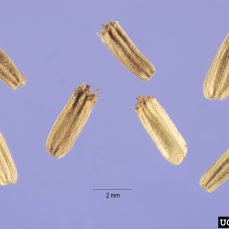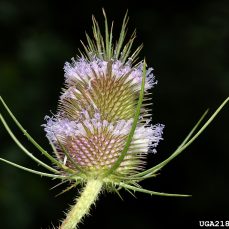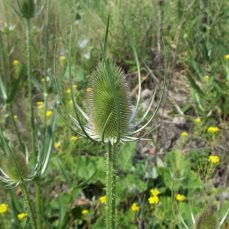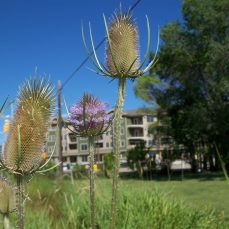
Photo Credit: Steve Dewey, Utah State University, Bugwood.org
Management Category
Squamish
Whistler
Pemberton
Vectors of Spread
Synonyms
- Dipsacus sylvestris
- Common teasel
- Fuller’s teasel
- Barber’s brush
- Brushes and combs
- Card teasel
- Card-thistle
- Church broom
- Gypsy-combs
- Venus’ basin
- Venus’-cup
- Wild teasel
ID Characteristics
General: Teasel is a biennial noxious weed from the Caprifoliaceae family.
Flowers: Purple, prickly, egg-shaped clusters, protected below by thin, rigid leaves (bracts). Flowers first form in a ring around the middle of the head, and may start to form two rings as the centre dies off.
Stems: Erect and up to 2 m tall, with scattered white prickles and longitudinal ridges. Typically, they are pale green and branched near the top.
Leaves: In its first year, teasel has large, shiny, rosette leaves with scalloped edges and stout prickles on the upper surface. The second year, leaves on the stem are smaller, broader towards the base and tapered towards the tip. They are positioned opposite from one another and have short spines on the underside. Leaves remain over winter as a basal rosette.
Fruit: Light brown and hairy fruits enclose a single seed measuring 2 – 3 mm long.
Roots: Teasel has a strong, thick taproot that may extend more than 60 cm deep, with fibrous secondary roots.
Similar Species
Invasive

Scotch Thistle (J. Leekie)
Scotch thistle (Onopordum acanthium) is present within the Sea to Sky. Teasel can be distinguished by its leaves, having the combination of a broad, cup-like base, tapered end and wavy margins.
Habitat and Origin
Teasel is native to Europe and originally introduced to North America in the 1800s because its dried flowers were used in wool production by teasing the wool apart (hence its common name). This species was first recorded in Canada in 1877.
Teasel prefers moist, sunny, open sites with rich soils. It favours disturbed areas such as roadsides, ditches, waste places, riparian sites, fields and pastures.
How it Spreads
Teasel is a biennial weed; in its first year, it forms a rosette, which will bolt and go to seed the following year. This plant reproduces solely by seed, developing more than 2000 seeds per plant, with a 30 – 80% germination rate. Teasel is also monocarpic, which means it dies after it flowers.
Seeds are small and light so they are easily dispersed by wind. Birds may also eat the seeds and spread them in their droppings, which helps teasel disperse over longer distances. Seeds may also spread through water. Finally, the dried blossoms of teasel are frequently used in flower arrangements, where the seeds may spread if the flowers are not disposed of properly.
Impacts
Ecological:
- Outcompetes native vegetation, decreasing biodiversity.
- Form dense stands, which decrease habitat and food availability for wildlife.
Economic:
- May invade crop and farmland, impacting crop growth and livestock.
Prevent the Spread
Teasel is found in the Sea to Sky region, but with a limited distribution. The goal is to eradicate this species from the region, and to prevent new introductions.
Learn to identify teasel: use the images presented on this profile page to learn how to identify Teasel.
What to do if you spot it: You can report any teasel sighting by visiting our reporting page.
DO:
- Regularly monitor properties for weed infestations.
- Minimize soil disturbances and promptly revegetate disturbed areas to prevent the growth of teasel.
- Check wildflower mixes to ensure that they do not contain teasel.
- Ensure all flowering heads or buds are bagged or covered to prevent spread during transport to designated disposal sites.
DO NOT:
- Unload, park or store equipment or vehicles in infested areas; remove plant material from any equipment, vehicles or clothing used in such areas and wash equipment and vehicles at designated cleaning sites before leaving infested areas.
- Plant teasel in a garden, no matter how well-contained its enclosure may seem.
- Compost any flowering heads or buds. Instead, dispose of teasel in the general/household waste stream at the landfill as the seeds will be able to persist the composting process.
- Move soil, gravel, or fill that has been contaminated with teasel.
Control
Mechanical
- Mowing is not effective for controlling teasel as the plant can re-sprout from the root crown.
- To prevent re-sprouting, dig up rosettes and remove as much of the root as possible.
- If stalks have begun to grow, cut only once flowers have formed and remove stalks from the area.
Chemical
- Glyphosate, triclopyr and 2,4-D are very effective on Teasel.
- Foliar spray with triclopyr can be effective if applied before the plant has bolted.
- If possible, apply herbicide in the late fall or early spring so as not to impact desirable native vegetation.
We recommend that any herbicide application is carried out by a person holding a valid BC Pesticide Applicator Certificate. Before selecting and applying herbicides, you must review and follow herbicide labels and application rates; municipal, regional, provincial and federal laws and regulations; species-specific treatment recommendations, and site-specific goals and objectives.
Biological Control
- There is no biological control available in Canada for this plant.
Teasel Distribution
Teasel Factsheet
Having trouble viewing the factsheet? Don’t worry, all the information is included on this page. You can also contact us with any questions.
References
- Centre for Agriculture and Bioscience International, Dipsacus fullonum (common teasel)
- Corteva Agriscience, Invasive Plant Management with Milestone and Other Herbicides: A Practical and Technical Guide for Natural Area Managers
- Invasive Plant Atlas of the United States, Common Teasel
- Invasive Species Extension, Dipsacus fullonum, Common Teasel
- Invasives Species Council of BC, Teasel
- King County, Common Teasel Identification and Control
- Minnesota Department of Agriculture, Teasel
- Northern Arizona Invasive Plants, Teasel
- Ohio State University, Ohio Perennial and Biennial Weed Guide
- Purdue University, Teasel
- Southeastern Wisconsin Invasive Species Consortium, Teasel
- Texas Invasive Species Institute, Common Teasel
- University of Illinois, Invasive Species Spotlight: Teasel
- Washington State Noxious Weed Control Board, Common Teasel

















